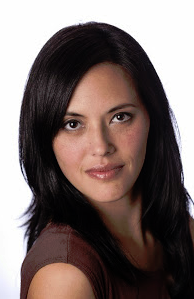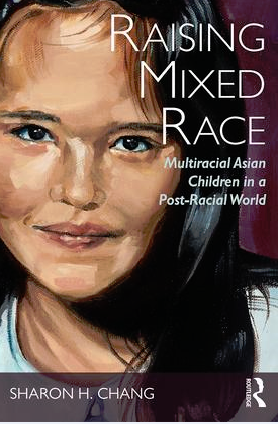Talking about race is complicated enough but how do parents of multiracial Asian American children talk to their kids about race and racial identity? What are the experiences of multiracial Asian American children? What’s missing in the media representations of multiracial kids?
Writer, scholar and activist Sharon H. Chang talked with AsAmNews about her multiracial family and the findings from her research on multiracial Asian American children from her new book Raising Mixed Race: Multiracial Asian Children in a Post-Racial World. The book will be officially launched with a virtual release party on Facebook this coming Friday, Dec 11 from 9:30 a.m. – 1:30 p.m. PST. Chang will give out four signed copies of her book plus numerous other prizes.
Below are some edited excerpts from their conversation.
You and your husband are both multiracial Asian Americans—describe your family’s cultural mash-up.
Our collective family ancestry is Japanese, Taiwanese/Chinese, Slovakian, German, French Canadian, British, Welsh – American. But culturally we feel multiethnic, mixed, 2nd gen Asian American.
How do you and your husband talk about your child about being multiracial in America?
We talk pretty openly about systemic racial inequities in front of him. We don’t hide those struggles and even encourage him to participate in the conversations when he’s interested. Then regarding his own identity (i.e. relationship to those racial struggles) we don’t tell him he’s white. Because he’s not. He’s certainly asked, “Am I white?” And we’re very clear, “No.” Instead we offer Asian, Asian American, and mixed.
How does your 5-year-old child describe his racial identity? How has it changed over time as he got older?
At this point he understands himself as Asian and American. He’s still confused about different “types” of Asians. He knows that his ancestry includes Japanese/Taiwanese/Chinese but doesn’t always get that those are subcategories. We’re also still working on the “mixed” part which seems to confuse him even more (he just gets quiet when we talk about it). That said he at least has vocabulary for mixedness and does recognize that some of his relatives are white. We’ll get there 🙂
What’s the most hardest, surprising and fun thing about raising a multiracial kid?
The hardest thing: socially there still isn’t much acknowledgment of who he is. It’s hard to find learning environments, books, toys, TV/film, even friends etc. that are affirming and make him feel good about himself. The most surprising thing: once we gave him the chance to have racial conversations with us he’s proven himself immensely capable, thoughtful and profound on matters of race almost from the start. The most fun thing: is we get to be a family of mixed race Asians together! There’s so much about each other’s experiences that we just understand without needing to say a single word.
What’s one of your favorite meals that reflect your family’s cultural mash-up?
Well I have a food story to share that doesn’t reflect my favorite meal but definitely reflects the spirit of our family’s mixedness in every sense. A couple years ago my son got a wicked flu and couldn’t eat anything but rice, applesauce and bananas for probably 7 days. He got pretty skinny. No energy. When he finally felt well enough to hold down everyday foods we were ready to spoil him, give him anything he wanted. I said, “Okay I think you’re ready to eat a real meal. What do you want??” His answer? Salmon sashimi and mac n cheese. I know.
As a parent, advocate and former teacher, what sorts of messages are multiracial kids currently receiving in schools and society in general?
Predominantly nothing. Which is a huge problem. Children of color in general either tend to get left out of school curriculum and societal teachings or hyper-visibilized in negative, harmful ways. Multiracial kids – since mixed race is still not often considered a “legitimate” group (by both whites and people of color alike) – often experience an added layer of invisibility that is so damaging for their self-esteem. Multiracial children don’t fit typical racial constructs and complicate the conversation in a way folks don’t like. When others feel discomfort and disequilibrium, it leads them to dismiss, gloss over, minimize or scoff at mixed race experiences. This often then leads multiracial children to feel they cannot be their whole authentic self on any front unless they’re willing to subscribe to prescribed racial categories.
What have you learned in the research for your new book, Raising Mixed Race: Multiracial Asian Children in a Post-Racial World, on how parents of multiracial children talk about race and racism?
Unfortunately I learned they don’t really talk to their multiracial children about race and racism. Mirroring larger society, the racial experiences of mixed race children are also predominantly ignored or underestimated by their caregivers. Parents tended to either (a) dismiss the possibility of their children experiencing racism by romanticizing their children’s mixedness as post-racial, or, (b) if they acknowledged the possibility of their children experiencing racism didn’t want to talk to their kids about it because they felt they were “too young” to understand.
What’s the funniest or strangest thing you heard from your interviews with parents and kids about being multiracial?
Well this isn’t so strange if we really think about it, but one of the most bizarre things was when I asked parents about raising their children to have positive multiracial identity – and they started talking to me about eating. What they and their children enjoy eating and cooking, restaurants they go to, what they would like to try eating, what their extended families serve or don’t serve at holidays. To be fair parents were addressing cultural identity as a substitute for racial identity (and there is certainly a lot of racial tension projected onto food) but in the moment it was often surprising. Like, I just asked you about race/racism and you’re talking to me about different types of dumplings?
You are located in the Seattle area—what is the diversity like for people of color, multiracial Asian children in particular? Tell me about your community activism.

There’s a very particular racial dynamic in Seattle that is incredibly difficult for people of color. Because the area votes liberal and often supports progressive measures/moves like legalizing marijuana or same-sex marriage, it is widely considered a “progressive” region. But that masks the fact that – while there are pockets of notable racial diversity and multiracial populations – Seattle is at the end of the day still a white-dominated city with no better racial outcomes than anywhere else (in fact escalating racial tensions) and very active white supremacist groups in surrounding outlying areas. What happens then when it comes to race/racism is that people of color live under a very harmful veil of white pseudo-progressivism that is dreamily hippy-happy and refuses to see inequity. This avoidance in turn then not only invisibilizes racial realities but often gives racism a “hall pass” in colorblind, avoidant and scary ways. It makes true progress that much harder.
#WeNeedDiverseBooks is one example of a movement to push for better representations of people of color in books for children. Your website has a great list of multiracial Asian children’s books. What are some of your favorite books and media does a great job depicting multiracial characters?
Big Hero 6 was exciting being a mainstream film where the protagonist (‘Hiro’) is mixed-race Asian. However, the movie still subscribes to traditional tragic tropes of mixedness: Hiro’s parents have died, are never pictured in the film, and *spoiler alert* his brother then dies too leaving Hiro alone (i.e. “orphaned”). I think right now books are the best place to find progressive depictions of mixed-race – though there isn’t much when it comes to mixed-race Asian. One of my hands down favorite picture books is Two Mrs. Gibsons. It’s still the only children’s book I’ve personally seen depicting a Black/Asian child. And I do also like Kip Fulbeck’s Mixed: Portraits of Multiracial Kids for raising the bar on what visibility can look like for mixed-race kids in its vast, vast scope of representation.
What stories about multiracial Asian kids aren’t being told that you’d like to see?
That they are racialized beings who live in a racist society too. That they experience race and racism. That they’re so-called ambiguity does not “immunize” or “exempt” them from being targeted and hurt by said discrimination. That they need tools as much as any person of color for feeling good about who they are and then becoming politically conscious, aware and engaged citizens committed to undoing social injustice. And that the tools they need are specific and not necessarily the same as what others need.
What bugs you the most about mainstream media’s description of multiracial people as staggeringly beautiful creatures such as this article and this other one?
What’s so concerning about this trend is not that folks are being called beautiful – but that they are being called the most beautiful because of their race. The implication? That multiracials are “better” than other races because of the way they look. That is an incredibly prejudicial way to look at attractiveness and ultimately just reinforces racist thinking. Further when others glorify mixed beauty they often tend to equate race-mixing with genetics, or, race as biology. But race is not biological. Again, reinforces racist and tone-deaf thinking. All together this then becomes a very dangerous, avoidant way to romanticize race by leveraging mixed-race faces which gets us away from the kind of reality-check work we should actually be doing; learning to see widespread, very real racism that persists every day.
SHARON CHANG
Has worked with young children and families for over a decade as a teacher, administrator, advocate and parent educator. She is currently a writer, scholar and activist who focuses on racism, social justice and the Asian American diaspora with a feminist lens. Her pieces have appeared in BuzzFeed, ThinkProgress, Hyphen Magazine, ParentMap Magazine, The Seattle Globalist, AAPI Voices and International Examiner. Her debut book Raising Mixed Race: Multiracial Asian Children In a Post-Racial World is coming out this December through Routledge. She also serves as a consultant for Families of Color Seattle and is on the planning committee for the Critical Mixed Race Studies Conference.
You can follow her at: @multiasianfams
ALICE WONG
Alice Wong is a researcher and disability advocate who dabbles part-time as a freelance journalist. She is a contributor to The Nerds of Color and Model View Culture. She’s also the founder of the Disability Visibility Project, a community partnership with StoryCorps collecting the oral histories of people with disabilities. You can follow her @SFdirewolf


RE: Parents of multiracial kids just don’t understand: You guys keep talking about it among yourselves. We real Hapas are shining a light on the disgusting things that really go into making us.
How long do you guys think you can keep pretending this isn't real?
In what single world, planet or universe is it possible for a child to be well adjusted when his own mother was a white supremacist?